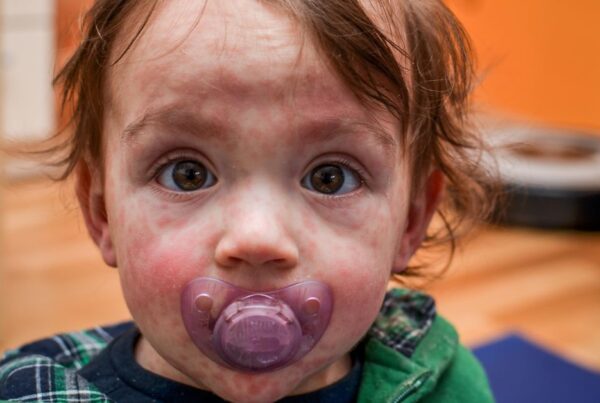Vitamin D is essential for proper immune function and optimal bone health, and it provides protection from chronic diseases and cancer (1). In the US, about 50% of children ages 1 to 5, and 70% of children ages 6 to 11, have low vitamin D levels and about 42% of adults have low vitamin D levels (2).
In this article, I’ll address the importance of vitamin D, how much vitamin D you really need, how to get vitamin D from the sun, dietary sources of Vitamin D, and when to consider supplementation. I’ll also share two of my favorite recipes that are kid-approved and rich in vitamin D.
The Importance Of Vitamin D
Vitamin D is an essential piece of the puzzle that is our general wellbeing and is needed for various vital functions. Vitamin D is perhaps best known for it’s important role in bone health and calcium metabolism, but it’s importance goes much further (1)! One of its foremost roles lies in bolstering our immune system. Adequate vitamin D levels contribute to the proper functioning of immune cells (3), enabling them to efficiently detect and neutralize invading pathogens.
This immune support extends beyond acute illness protection, as emerging research suggests that optimal vitamin D status may be linked to a decreased risk of autoimmune disorders (4), where the immune system mistakenly attacks healthy cells. There is also a link between vitamin D and cardiovascular health, as adequate vitamin D levels are associated with improved heart function and reduced risk of heart disease (5). Similarly, ongoing research is seeing potential for this nutrient to prevent the onset and progression of certain types of cancer (6).
Vitamin D’s influence extends to mental health where it appears to play a role in mood regulation and cognitive well-being (7). Interestingly, there are vitamin D receptors dispersed throughout the brain, and there is some research that points towards vitamin D playing a potential role in lessening the symptoms of depression (8).
How Much Vitamin D Do You Really Need?
The IOM (Institute of Medicine) recommends that most adults get 15 micrograms (mcg) or 600 international units (IU) of vitamin D per day to maintain adequate vitamin D levels (3).
For children, the IOM recommends the following:
- 0-12 months: 10 mcg (400 IU)
- 1-13 years: 15 mcg (600 IU)
- 14-18 years: 15 mcg (600 IU)
For adults, the IOM recommends the following:
- 19-71 years: 15 mcg (600 IU)
- 71+ years: 20 mcg (800 IU)
In my practice, I usually recommend that adults get 50-100 mcg (2,000-4,000 IU) and children get 25-50 mcg (1,000-2,000 IU) of vitamin D per day for optimum health. Babies are recommended 10 mcg (400 IU) from birth. Remember, this can come from supplements, sun exposure, or food. In my family, we focus on sun exposure and food rather than supplements, but it really depends on where you live and your lifestyle.
Although the ‘adequate’ amount of vitamin D to prevent acute health concerns is around 20-50 ng/mL, the optimum serum level of vitamin D for long term health is around 50-80 ng/mL (3).
 Vitamin D From The Sun
Vitamin D From The Sun
Vitamin D is synthesized in the skin when exposed to sunlight. Estimates on the amount of vitamin D the body can make from sunlight vary greatly; I’ve seen estimates from 10-200 IU per minute. Factors like skin color, latitude, time of day, season, cloud coverage, ozone, how much of the body is exposed, and the amount of sunscreen worn influence this. Additionally, your epigenetics, and even your stress levels, play a part in determining how effectively your body synthesizes vitamin D (4).
Dietary Sources of Vitamin D
In addition to obtaining vitamin D from the sun, we can also get vitamin D from the food we eat. Vitamin D is a fat soluble vitamin, and is found in fatty fish, eggs, and dairy. Many foods are also fortified with vitamin D, such as commercial milk and orange juice.
Table 1
Top Food Sources of Vitamin D
| Food | IU per serving |
| Salmon, 3 ounces | 447 IU |
| Tuna, 3 ounces | 70 IU |
| Mackerel, 3 ounces | 855 IU |
| Herring, 3 ounces | 182 IU |
| Sardines, 3 ounces | 164.1 IU |
| Egg yolk, 1 large | 37.7 IU |
| Cod liver oil, 1 tablespoon | 1,360 IU |
| Beef liver, 4 ounces | 55.4 IU |
| Swordfish, 3 ounces | 566 IU |
| Raw Milk, 1 qt | 381 IU |
Note. The data for food sources of vitamin D (except raw milk) is from FoodData Central. Fooddata Central. (n.d.). The raw milk data is from Lutz, K. (2023, April 24). What’s the importance of the fat soluble vitamins in raw dairy products? RAW FARM usa.
When To Consider Supplementation
Factors such as limited sunlight exposure, picky eating, restrictive diet, darker skin tone, indoor lifestyle, geographical location, and specific health conditions should be considered when deciding if a vitamin D supplement is needed. I frequently recommend that my patients take vitamin D short term when they are fighting a virus or traveling and their immune systems may need a boost.
It is generally advised that breastfed infants should be supplemented with 10 mcg (400 IU) of vitamin D. Safe sun exposure is an alternate option as is maternal supplementation with vitamin D. An in depth study found that “maternal vitamin D supplementation with 6400 IU/day safely supplies breast milk with adequate vitamin D to satisfy her nursing infant” (7).
For information on how to put together a supplement regime for your family, see: How To Create A Daily Supplement Protocol For Your Family – Dr. Green Mom.
My Favorite Vitamin D Recipes
These recipes are foods I enjoy at home with my family. Both are naturally rich in vitamin D, and both are approved by my kids!
 Dr. Green Mom’s Sardine-Melts
Dr. Green Mom’s Sardine-Melts
I recommend serving the sardine melts hot. Enjoy this extra nutrient dense twist on the classic tuna melt!
⏲️ Prep Time
10-20 mins.
🍴 Serves
2
Ingredients
- 1 can of bone-in sardines in oil
- 4 slices of your favorite bread (I love sourdough!)
- 1/4 cup mayonnaise (I prefer the primal kitchen or chosen foods brand as both are made with avocado oil)
- 1/4 cup diced red onion
- 1/4 cup diced celery
- 1 tablespoon lemon juice
- 1 teaspoon Dijon mustard
- 2 slices of cheddar cheese
- 2 tablespoons butter, softened
Directions
- Preheat your panini press or oven to 375°F
- Drain the sardines from the oil and remove any large bones, leaving the smaller bones intact for added calcium and flavor, and mash them up
- In a medium bowl, combine the mashed sardines with diced red onion, diced celery, mayonnaise, lemon juice, and Dijon mustard. Mix well to make the sardine salad.
- Butter one side of each slice of bread.
- Place the bread slices buttered side down on the panini press or on a baking sheet if you’ll be using the oven.
- Spread a generous amount of the sardine salad on top of the bread.
- Lay a slice of cheddar cheese on top
- Place the top piece of bread on top, buttered side facing out.
- If using the panini press, press it closed; if using the oven, place the baking sheet with the assembled sardine melts in the preheated oven.
- Bake in the panini press for 3-4 minutes, or about 10-12 minutes in the oven, until the bread is toasted and the cheese is melted and bubbly.
- Remove the sardine melts from the press or oven and let them cool for a minute or two before serving.
 Dr. Green Mom’s Raw Milk Vanilla Ice Cream
Dr. Green Mom’s Raw Milk Vanilla Ice Cream
A note on raw milk: Raw milk may be hard to find in some states. A good resource for finding raw milk is GetRawMilk.com. If raw milk isn’t available or you prefer alternatives, opt for vat pasteurized, organic, grass-fed, A2 whole milk for easier digestion and higher nutrient density.
⏲️ Prep Time
Varies
🍴 Serves
Varies
Ingredients
- 2 cups raw milk
- 1 cup raw cream
- 4 large egg yolks (from pasture-raised eggs)
- 1 tablespoon pure vanilla extract
- 1/2 cup maple syrup (adjust to taste)
Directions
- Combine all ingredients in a blender for about 30 seconds or until mixture is smooth.
- Pour mixture into an ice cream machine, following your machine’s instructions.
Summary
This article discusses the importance of Vitamin D, its sources, and supplementation considerations. It highlights the significance of Vitamin D for the immune system and bone health, along with the high rates of low Vitamin D levels in both children and adults in America.
Vitamin D can be obtained from sunlight and dietary sources. Supplementation may be done short term, such as when fighting an illness, or longer term or seasonally based on factors like limited sun exposure, breastfeeding status, or specific health conditions.
References:
- Christakos, S., Hewison, M., Gardner, D. G., Wagner, C. L., Sergeev, I. N., Rutten, E., Pittas, A. G., Boland, R., Ferrucci, L., & Bikle, D. D. (2013). Vitamin D: beyond bone. Annals of the New York Academy of Sciences, 1287(1), 45–58. https://doi.org/10.1111/nyas.12129
- Chauhan K, Shahrokhi M, Huecker MR. Vitamin D. [Updated 2023 Apr 9]. In: StatPearls [Internet]. Treasure Island (FL): StatPearls Publishing; 2023 Jan-. Available from: https://www.ncbi.nlm.nih.gov/books/NBK441912/
- Institute of Medicine (US) Committee to Review Dietary Reference Intakes for Vitamin D and Calcium; Ross AC, Taylor CL, Yaktine AL, et al., editors. Dietary Reference Intakes for Calcium and Vitamin D. Washington (DC): National Academies Press (US); 2011. 5, Dietary Reference Intakes for Adequacy: Calcium and Vitamin D. Available from: https://www.ncbi.nlm.nih.gov/books/NBK56056/
- Guarnotta, V., Di Gaudio, F., & Giordano, C. (2022). Vitamin D Deficiency in Cushing’s Disease: Before and After Its Supplementation. Nutrients, 14(5), 973. MDPI AG. Retrieved from http://dx.doi.org/10.3390/nu14050973
- FoodData Central. Fooddata Central. (n.d.). https://fdc.nal.usda.gov/index.html
- Lutz, K. (2023, April 24). What’s the importance of the fat soluble vitamins in raw dairy products? RAW FARM usa. https://rawfarmusa.com/blog/benefits-of-the-fat-soluble-vitamins-in-raw-dairy-products
- Oberhelman, S. S., Meekins, M. E., Fischer, P. R., Lee, B. R., Singh, R. J., Cha, S. S., Gardner, B. M., Pettifor, J. M., Croghan, I. T., & Thacher, T. D. (2013). Maternal vitamin D supplementation to improve the vitamin D status of breast-fed infants: a randomized controlled trial. Mayo Clinic proceedings, 88(12), 1378–1387. https://doi.org/10.1016/j.mayocp.2013.09.012


